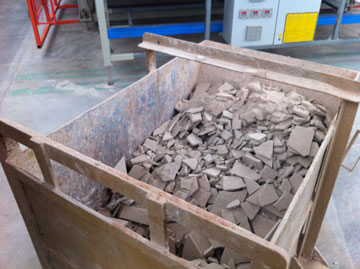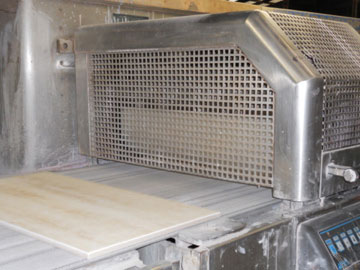I recently had the honor of taking part in ASCER’s Reign in Spain trip to several cities in Spain, culminating at Cevisama, the world’s second largest trade  fair for all things tile. Quite literally, it was all things, from building facades to drainage systems to bookshelves. Look for additional posts about the trip and the show to come in the very near future.
fair for all things tile. Quite literally, it was all things, from building facades to drainage systems to bookshelves. Look for additional posts about the trip and the show to come in the very near future.
Another amazing part of the trip was the group’s visit to Keraben Ceramica’s factory just outside Valencia. As a relative newbie to the flooring industry, I’ve  only been on a few factory tours and they were always replicas of the real thing or the facility had been shut down for noise and safety reasons. After touring the real thing in Spain I can truly see why: My ears rang for a good 30 minutes after leaving the facility and I personally set off no less than three alarms for getting too close to the machinery.
only been on a few factory tours and they were always replicas of the real thing or the facility had been shut down for noise and safety reasons. After touring the real thing in Spain I can truly see why: My ears rang for a good 30 minutes after leaving the facility and I personally set off no less than three alarms for getting too close to the machinery.
Nonetheless, the staff who showed us around were extremely informative and good-natured about the whole tour that lasted close to two hours. After a CEU course with tile consultant Patti Fasan and a presentation from Keraben’s industrial engineer, Miguel, the group got a tour of the process from beginning to end with a special look at a new quality control machine deemed close to 20 times more accurate than the human eye.
 Here is a bin of scrap material from the production process. Every last piece of tile is collected and put back into the ball-sling to be ground into the even consistency required for reliable tile. Considering that tile is actually made of dirt and tile, I thought it would be a messy process but my initial impression of the factory was how clean it was. One of our fellow observers actually dragged a finger along the floor to see if it was just the gray cement. But it really was that clean.
Here is a bin of scrap material from the production process. Every last piece of tile is collected and put back into the ball-sling to be ground into the even consistency required for reliable tile. Considering that tile is actually made of dirt and tile, I thought it would be a messy process but my initial impression of the factory was how clean it was. One of our fellow observers actually dragged a finger along the floor to see if it was just the gray cement. But it really was that clean.
 Here, a tile goes through several roll presses for color and implied texture. Many of Keraben’s products go through both rolled and jet-applied ink processes for added visual complexity.
Here, a tile goes through several roll presses for color and implied texture. Many of Keraben’s products go through both rolled and jet-applied ink processes for added visual complexity.
 Keraben also uses the engobe process, a primer-like process that enhances color and helps seal the glaze to the tile. It was described to the Reign in Spain group in terms we could grasp: It’s like glazing a Krispy Kreme.
Keraben also uses the engobe process, a primer-like process that enhances color and helps seal the glaze to the tile. It was described to the Reign in Spain group in terms we could grasp: It’s like glazing a Krispy Kreme.
 The tiles are then sent through a roller kiln that reaches temperatures of up to 1200° Centigrade, or close to 2200° Farenheit. It got a little chilly in the warehouse and this was my favorite part.
The tiles are then sent through a roller kiln that reaches temperatures of up to 1200° Centigrade, or close to 2200° Farenheit. It got a little chilly in the warehouse and this was my favorite part.
Moving up the production line, we got an idea of how enormous the factory and production output is. The entire process took about 45 minutes per tile, yielding about 9,000 square meters of 9mil tile and 5,000 square meters of 11mil tile per day.
-Emily
For more images of the tour through Keraben’s tile factory, visit our Flickr album.


